Last week, we noted what was lacking in the UJA-Federation of New York survey concerning the Chabad Lubavitch Movement. This brings us to think about the activities of the Rebbe when he became Rebbe in 1951. It was just a few years after the Holocaust when the Jewish community was broken and desperate. The Jews who remained were generally divided into two camps, one camp that was already observant and the other camp that was not yet observant. The distance between the two camps was very large. Everyone was busy with themselves and with their own survival, and rightfully so, because thatâs what they were worried about after the Holocaust, when the Jew was left broken and forsaken â without a home, without a source of income, still fighting for his survival.
The Rebbe was concerned about the condition of the Jewish people, and he did everything he could to bridge the gap between these two camps. The Rebbe sent his shluchim all over the world so that they could establish contact with the Jews who were not yet observant or even with the Jews who, for whatever reason, had, for that moment, no desire to enhance their observance.
In this manner, the Rebbe succeeded in bringing back a great deal of our brethren. The Rebbe was not fond of the term âkiruv rechokimâ because that means that we are drawing close âthose who are far.â A Jew is never far or distant. Itâs only that sometimes, there are circumstances beyond his control that make him appear to be not so close. But thatâs not because he is far in principle. This is why every Jew we reach is brought back closer to his original source, to what he was originally, to his parents or his grandparents or his great-grandparents.
Amazingly, today there are over one thousand Chabad centers in the United States, and in every single one of the 50 states there is a Chabad house. The same is true all over the world. You cannot find a country or a large city that does not have a Chabad representative. It is also interesting that in some countries, the Chabad representative or the Chabad presence is the Judaism of the country. The areaâs entire connection with Judaism is through Chabad. In Australia, South Africa, Russia and all the FSU (Former Soviet Union) countries, India, Thailand, Vietnam, and Central Asia, all synagogues are either officially Chabad or have a Chabad rabbi. In Israel, there are over one thousand Chabad institutions and centers.
Some demographers, including Pew and other federations, have created a new line of questioning designed to analyze Chabad involvement. Instead of asking them what type of Jew they think they are, the surveys encourage participants to express their Jewish identity in more depth. Questions like âDo you attend Chabad?â or âDo you support Chabad?â have revealed interesting trends. According to the recent Pew survey results, for instance, the vast majority of Jews in the U.S. attending Chabad (over 75%) do not identify as Orthodox. To take another example, in the 2014 Greater Miami Jewish Federation Population Study, 46% of Jews under 35 said they are involved with Chabad.
The fact that there were no questions about Chabad involvement in the New York UJA-Federation survey is even more perplexing when you consider Chabadâs growth. Today there are over 1,000 Chabad centers in the U.S., representing a growth rate of 200% in the past 20 years. By contrast, the Reform movement has closed almost 25% of their congregations, and the Conservative movement, 38%, according to a 2020 Pew study.
The goal of the Rebbe, however, was ânever to be satisfiedâ and to bring more light to this world, to reach more Jews in this world, and to make sure that there isnât a Jew that is outside of the realm. As the Rebbe said, if we work with a city and we reach 99.9% of the people but miss 0.1%, then we have not completed our job. Our job is to reach each and every single Jew.
Especially now, as we stand at the threshold of the coming of Moshiach, we need each and every single Jew. It doesnât matter how distant they may seem. We have to bring them closer and work with them in any measure they are willing to take, however small. Thereâs no mitzvah that is too small, even if it means giving one penny of tzedakah, putting on tefillin one time, or lighting Shabbos candles one time. The mitzvah is valuable in and of itself, and we also never know what this small positive act will lead to in the future. As the Rebbe told Binyamin Netanyahu when he was ambassador to the United Nations, âIf you light a small candle in a dark place, its light will be seen from far away.â
We have to do all we can to reach out to every single Jew and prepare ourselves and our part in this world for the coming of Mashiach, speedily, in our very own days.


